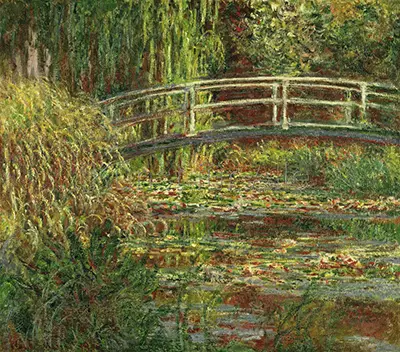Whilst already owning a small garden on the side of his house, Monet decided to become more ambitious in order to allow himself a wider variety of options when it came to producing paintings in an accessible location such as this. He therefore purchased some land that adjoined his own property and set about developing it in order to have the right environment in which to work. By the time it was finished, Monet would now be able to construct all manner of different compositions by simply changing his position and angle within this new garden. Water became a key element of this new extension and his water lily pond and bridge would breathe new life into his career. He could work without interference and also could now work at any time of the day, allowing him to better understand changing conditions of his local environment.
Harmony in Pink allows the artist to bias towards a particular tone in a similar way to how he worked with The Waterlily Pond, Green Harmony. The difference in this painting here, however, is that he is not sat directly facing he centre of the bridge, but actually is a little more off to the left. This means that we see the start of the bridge on oneside, albeit disguised by a small bush, whilst the right hand side of the bridge is abruptly cropped out. Monet may have learnt about aggressive cropping from Japanese art, where the technique was used fairly commonly. We do know that he appreciated art from this region and it also clearly influenced the style of bridge that he chose to implement in the artist's garden. It is rare to find someone who is so devoted to his work that he would ho to such lengths of preparation, but it must not be forgotten that Monet was also a particularly keen gardener who would have enjoyed putting together this charming display of nature.
All-in-all, this painting offers an interesting twist from his series of paintings that captured the main focal point of his garden. He would sit here for hours, studying the changing impact of light and colour, and also enjoying the fruits of his labour, having spent so much time and money in preparing this area of his property. Whilst he continued to depict his older garden elements from time to time, it was the inclusion of water which really brought a new dimension to his work in Giverny and many thousands continue to visit this location today. Those who follow this same passion should take the time to compare his different versions of the same content, to understand the intricate variations that he alone would have understood when putting these series of paintings together.


